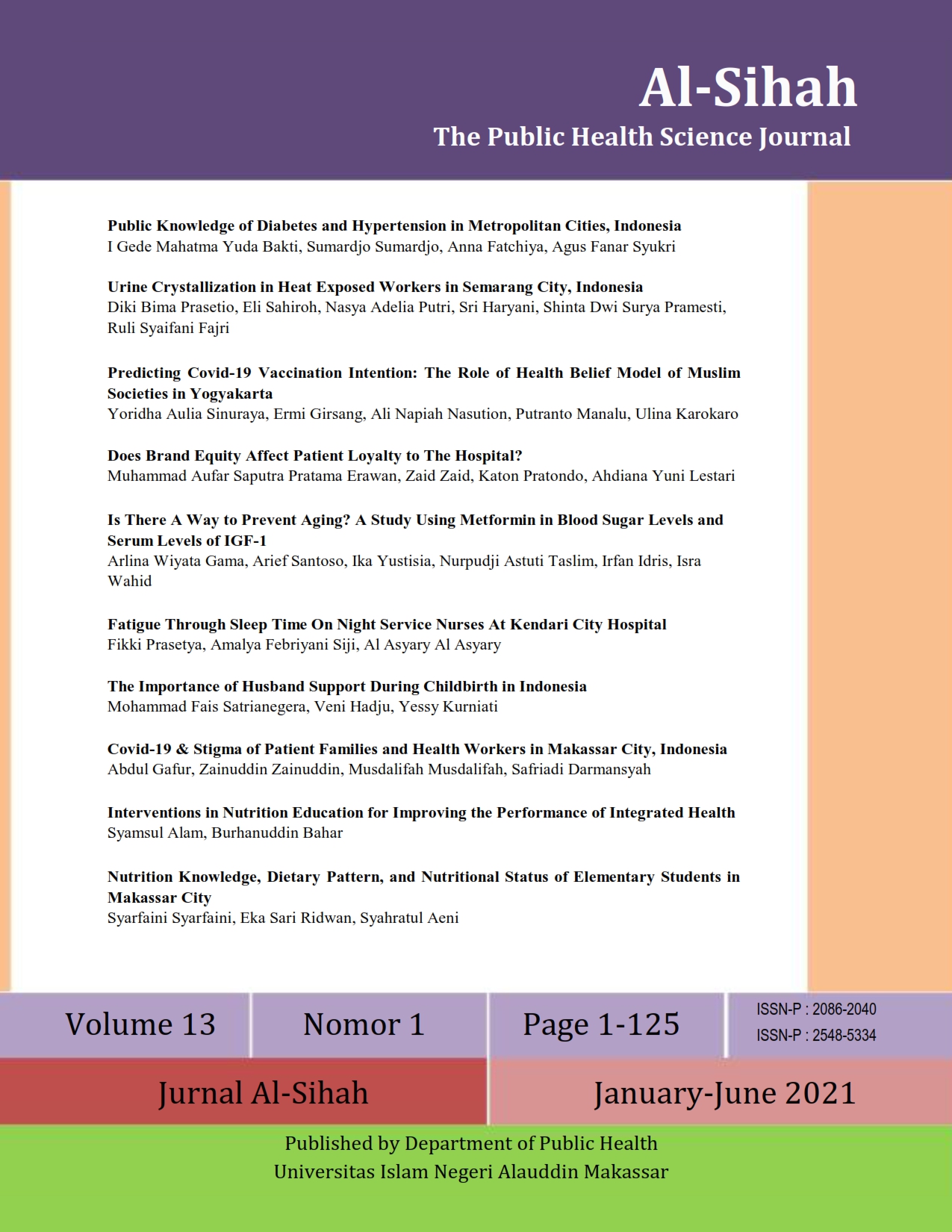Nutrition Knowledge, Dietary Pattern, and Nutritional Status of Elementary Students in Makassar City
Abstract
Elementary school children are a vulnerable group to nutritional problems. Malnutrition is generally caused by poverty, lack of food supplies, poor environmental quality, lack of public knowledge about nutrition, a balanced diet, and health. The purpose of this study was to analyze the relationship between balanced nutrition knowledge, dietary pattern, and nutritional status of children in Sekolah Dasar Islam Terpadu (SDIT) Makassar, Indonesia. The population in this study were all students in grades 4 and 5 with a total sample of 94 people. The results showed that there was no relationship between balanced nutrition knowledge and nutritional status (P = 0.397) and there was no relationship between diet pattern and nutritional status (P = 0.662) children at SDIT Makassar. Researchers recommend a Balanced Nutrition Ambassador program in every school. Ambassadors of Balanced Nutrition will be trained related to balanced nutrition and is responsible for disseminating balanced nutrition messages to their friends and their familyDownloads
References
Afrilia, D. A. (2018). Hubungan Pola Makan Dan Aktifitas Fisik Terhadap Status Gizi Di Siswa Smp Al-Azhar Pontianak. Pontianak Nutrition Journal (PNJ), 1(1), 10-13. https://doi.org/10.30602/pnj.v1i1.277
Al Yazeedi, B., Berry, D. C., Crandell, J., & Waly, M. (2021). Family influence on children's nutrition and physical activity patterns in Oman. Journal of Pediatric Nursing, 56, e42-e48. https://doi.org/10.1016/j.pedn.2020.07.012
Ali, B. M., Mohammed, S., Akram, S., Salar, S., Baxtiar, L., Ismail, L., & Nawzad, S. (2020). Knowledge, Attitude and Practice of Medical Students of Sulaimani Regarding Modern Lifestyle And Its Effect On Health. Kurdistan Journal of Applied Research, 49-62. https://doi.org/10.24017/science.2020.ICHMS2020.6
Amrah, A. (2013). Perkembangan Moral Anak Usia Sekolah Dasar. Publikasi Pendidikan, 3(1). https://doi.org/10.26858/publikan.v3i1.1602
Aoun, N., Matsuda, H., & Sekiyama, M. (2015). Geographical accessibility to healthcare and malnutrition in Rwanda. Social science & medicine, 130, 135-145. https://doi.org/10.1016/j.socscimed.2015.02.004
Asakura, K., Todoriki, H., & Sasaki, S. (2017). Relationship between nutrition knowledge and dietary intake among primary school children in Japan: Combined effect of children's and their guardians' knowledge. Journal of epidemiology, 27(10), 483-491. https://doi.org/10.1016/j.je.2016.09.014
Bagchi, T. (2014). Traditional food & modern lifestyle: Impact of probiotics. The Indian journal of medical research, 140(3), 333. https://www.ncbi.nlm.nih.gov/pmc/articles/PMC4248377/
Boo, M. N., Cho, S. K., & Park, K. (2015). Evaluation of dietary behavior and nutritional status of elementary school students in Jeju using nutrition quotient. Journal of Nutrition and Health, 48(4), 335-343. https://doi.org/10.4163/jnh.2015.48.4.335
Calder, P. C., Carr, A. C., Gombart, A. F., & Eggersdorfer, M. (2020). Optimal nutritional status for a well-functioning immune system is an important factor to protect against viral infections. Nutrients, 12(4), 1181. https://doi.org/10.3390/nu12041181
Corvalán, C., Garmendia, M. L., Jones‐Smith, J., Lutter, C. K., Miranda, J. J., Pedraza, L. S., & Stein, A. D. (2017). Nutrition status of children in Latin America. Obesity Reviews, 18, 7-18. https://doi.org/10.1111/obr.12571
Couteau, J. (2020). Hubungan antara Pengetahuan, Sikap dan Perilaku Gizi Seimbang Ibu dengan Status Gizi Anak SD Budya Wacana Yogyakarta [Thesis, Universitas Kristen Duta Wacana]. https://katalog.ukdw.ac.id/4026/
Cuenca, M. H., Proaño, G. V., Blankenship, J., Cano-Gutierrez, C., Chew, S. T., Fracassi, P., & Steiber, A. (2020). Building Global Nutrition Policies in Health Care: Insights for Tackling Malnutrition from the Academy of Nutrition and Dietetics 2019 Global Nutrition Research and Policy Forum. Journal of the Academy of Nutrition and Dietetics, 120(8), 1407-1416. https://doi.org/10.1016/j.jand.2020.03.011
Dipasquale, V., Cucinotta, U., & Romano, C. (2020). Acute Malnutrition in Children: Pathophysiology, Clinical Effects and Treatment. Nutrients, 12(8), 2413. https://doi.org/10.3390/nu12082413
Dominguez, V. A. H., & Halili, B. L. B. (2018). Food for Thought: The Socioeconomic Impact of Child Malnutrition and Maternal Health on the Academic Performance of Filipino School Children. European Journal of Sustainable Development, 7(4), 361-361. https://doi.org/10.14207/ejsd.2018.v7n4p361
Donin, A. S., Nightingale, C. M., Owen, C. G., Rudnicka, A. R., Cook, D. G., & Whincup, P. H. (2018). Takeaway meal consumption and risk markers for coronary heart disease, type 2 diabetes and obesity in children aged 9–10 years: a cross-sectional study. Archives of disease in childhood, 103(5), 431-436. http://dx.doi.org/10.1136/archdischild-2017-312981
Fadila, R. N., Amareta, D. I., & Febriyatna, A. (2017). Hubungan Pengetahuan Dan Perilaku Ibu Tentang Gizi Seimbang Dengan Status Gizi Anak Tk Di DesaYosowilangun Lor Kabupaten Lumajang. Jurnal Kesehatan, 5(1), 14-20. https://doi.org/10.25047/j-kes.v5i1.26
Fajriani, F., Aritonang, E. Y., & Nasution, Z. (2020). Hubungan Pengetahuan, Sikap dan Tindakan Gizi Seimbang Keluarga dengan Status Gizi Anak Balita Usia 2-5 Tahun. Jurnal Ilmu Kesehatan Masyarakat, 9(01), 1-11. https://doi.org/10.33221/jikm.v9i01.470
Farhadi, S., & Ovchinnikov, R. S. (2018). The relationship between nutrition and infectious diseases: A review. Biomedical and Biotechnology Research Journal (BBRJ), 2(3), 168. https://www.doi.org/10.4103/bbrj.bbrj_69_18
Fitri, Y., Al Rahmad, A. H., Suryana, S., & Nurbaiti, N. (2020). Pengaruh penyuluhan gizi tentang jajanan tradisional terhadap peningkatan pengetahuan dan perilaku jajan anak sekolah. AcTion: Aceh Nutrition Journal, 5(1), 13-18. http://dx.doi.org/10.30867/action.v5i1.186
Ijarotimi, O. S. (2013). Determinants of childhood malnutrition and consequences in developing countries. Current Nutrition Reports, 2(3), 129-133. https://doi.org/10.1007/s13668-013-0051-5
Irnani, H., & Sinaga, T. (2017). Pengaruh pendidikan gizi terhadap pengetahuan, praktik gizi seimbang dan status gizi pada anak Sekolah Dasar. Jurnal Gizi Indonesia (The Indonesian Journal of Nutrition), 6(1), 58-64. https://doi.org/10.14710/jgi.6.1.58-64
Jannah, M., & Kusumaningrum, I. (2021). Analisis Obesitas pada Anak Sekolah Dasar Berdasarkan Pengetahuan, Sikap, dan Paparan Informasi tentang Gizi Seimbang. ARTERI: Jurnal Ilmu Kesehatan, 2(3), 67-73. https://doi.org/10.37148/arteri.v2i3.168
Kementerian Kesehatan RI. (2014). Laporan Hasil Riset Kesehatan Dasar (Riskesdas). Badan Litbangkes Kementerian Kesehatan RI. https://www.litbang.kemkes.go.id/laporan-riset-kesehatan-dasar-riskesdas/
Kigaru, D. M. D., Loechl, C., Moleah, T., Macharia-Mutie, C. W., & Ndungu, Z. W. (2015). Nutrition knowledge, attitude and practices among urban primary school children in Nairobi City, Kenya: a KAP study. BMC Nutrition, 1(1), 1-8. https://doi.org/10.1186/s40795-015-0040-8
Kumar, S., & Preetha, G. S. (2012). Health promotion: an effective tool for global health. Indian journal of community medicine: official publication of Indian Association of Preventive & Social Medicine, 37(1), 5. https://dx.doi.org/10.4103%2F0970-0218.94009
Laenggeng, A. H., & Lumalang, Y. (2015). Hubungan Pengetahuan Gizi dan Sikap Memilih Makanan Jajanan dengan Status Gizi Siswa SMP Negeri 1 Palu. Healthy Tadulako Journal (Jurnal Kesehatan Tadulako), 1(1), 49-57. https://doi.org/10.22487/htj.v1i1.6
Lister, N. B., Gow, M. L., Chisholm, K., Grunseit, A., Garnett, S. P., & Baur, L. A. (2017). Nutritional adequacy of diets for adolescents with overweight and obesity: considerations for dietetic practice. European journal of clinical nutrition, 71(5), 646-651. https://doi.org/10.1038/ejcn.2016.268
Liszewska, N., Scholz, U., Radtke, T., Horodyska, K., Liszewski, M., & Luszczynska, A. (2018). Association between children's physical activity and parental practices enhancing children's physical activity: The moderating effects of children's BMI z-score. Frontiers in psychology, 8, 2359. https://doi.org/10.3389/fpsyg.2017.02359
Lonto, J. S., Umboh, A., & Babakal, A. (2019). Hubungan pola asuh orang tua dengan perilaku jajan anak usia sekolah (9-12 Tahun) di SD Gmim Sendangan Sonder. Jurnal Keperawatan, 7(1). https://ejournal.unsrat.ac.id/index.php/jkp/article/view/24338
Mavrovouniotis, F. (2012). Inactivity in childhood and adolescence: a modern lifestyle associated with adverse health consequences. Sport Science Review, 21(3-4), 75. https://doi.org/10.2478/v10237-012-0011-9
Muliawati, R. R., & Mardiyati, N. L. (2018). Hubungan Pengetahuan Memilih Makanan Jajanan dan Jumlah Uang Saku dengan Status Gizi Siswa SD Negeri Kleco II Surakarta (Doctoral dissertation, Universitas Muhammadiyah Surakarta). http://eprints.ums.ac.id/66841/
Ndemwa, M., Wanyua, S., Kaneko, S., Karama, M., & Anselimo, M. (2017). Nutritional status and association of demographic characteristics with malnutrition among children less than 24 months in Kwale County, Kenya. The Pan African Medical Journal, 28. https://dx.doi.org/10.11604%2Fpamj.2017.28.265.12703
Nova, M., & Yanti, R. (2018). Hubungan Asupan Zat Gizi Makro dan Pengetahuan Gizi dengan Status Gizi pada Siswa Mts. s An-nurkota Padang. JURNAL KESEHATAN PERINTIS (Perintis's Health Journal), 5(2), 169-175.
Noviani, K., Afifah, E., & Astiti, D. (2016). Kebiasaan jajan dan pola makan serta hubungannya dengan status gizi anak usia sekolah di SD Sonosewu Bantul Yogyakarta. Jurnal Gizi Dan Dietetik Indonesia (Indonesian Journal Of Nutrition And Dietetics), 4(2), 97-104. http://dx.doi.org/10.21927/ijnd.2016.4(2).97-104
Noviyanti, R. D., & Marfuah, D. (2017). Hubungan pengetahuan Gizi, Aktivitas fisik, dan pola makan terhadap status gizi remaja di kelurahan purwosari Laweyan Surakarta. URECOL, 421-426. https://journal.unimma.ac.id/index.php/urecol/article/view/1059
Octaviani, P., Izhar, M. D., & Amir, A. (2018). Hubungan Pola Makan Dan Aktivitas Fisik Dengan Status Gizi Pada Anak Sekolah Dasar Di SD Negeri 47/IV Kota Jambi. Jurnal Kesmas Jambi, 2(2), 56-66. https://doi.org/10.22437/jkmj.v2i2.6554
Oktafiana, R., & Wahini, M. (2016). Faktor-Faktor Yang Mempengaruhi Status Gizi Anak Usia Sekolah Pada Keluarga Atas Dan Bawah (Kasus Di Desa Sidoharjo, Kabupaten Ponorogo). Jurnal Tata Boga, 5(3). https://core.ac.uk/download/pdf/230743030.pdf
Panjaitan, W. F., Siagian, M., & Hartono, H. (2019). Hubungan Pola Makan dengan Status Gizi Pada Anak Sekolah Dasar Al Hidayah Terpadu Medan Tembung. Jurnal Dunia Gizi, 2(2), 71-78. https://doi.org/10.33085/jdg.v2i2.4448
Passos, D. R. D., Gigante, D. P., Maciel, F. V., & Matijasevich, A. (2015). Children's eating behavior: comparison between normal and overweight children from a school in Pelotas, Rio Grande do Sul, Brazil. Revista Paulista de Pediatria, 33(1), 42-49. https://doi.org/10.1016/j.rpped.2014.11.007
Pattola, P., Nur, A., Atmadja, T. F. A. G., Yunianto, A. E., Rasmaniar, R., Marzuki, I., & Purba, A. M. V. (2020). Gizi Kesehatan dan Penyakit. Yayasan Kita Menulis.
Pereira, P. F., Rita de Cássia, G. A., & Araújo, R. M. A. (2014). Does breastfeeding influence the risk of developing diabetes mellitus in children? A review of current evidence. Jornal de pediatria, 90(1), 7-15. https://doi.org/10.1016/j.jped.2013.02.024
Rahmayanti, D., & Astika E. (2016). Pola Makan Anak Dengan Status Gizi Anak Usia 6-8 Tahun Di SD Wilayah Kelurahan Cempaka. Dunia Keperawatan: Jurnal Keperawatan dan Kesehatan, 4(1), 8-13. http://dx.doi.org/10.20527/dk.v4i1.2504
Renata, P., & Dewajanti, A. M. (2017). Hubungan Pengetahuan, Sikap, dan Perilaku Tentang Gizi Seimbang dengan Status Gizi Siswa Kelas IV dan V di Sekolah Dasar Tarakanita Gading Serpong. Jurnal Kedokteran Meditek. 23(61). https://doi.org/10.36452/jkdoktmeditek.v23i61.1460
Shen, X., Gao, X., Tang, W., Mao, X., Huang, J., & Cai, W. (2015). Food insecurity and malnutrition in Chinese elementary school students. British Journal of Nutrition, 114(6), 952-958. https://doi.org/10.1017/S0007114515002676
Shinsugi, C., Gunasekara, D., Gunawardena, N. K., Subasinghe, W., Miyoshi, M., Kaneko, S., & Takimoto, H. (2019). Double burden of maternal and child malnutrition and socioeconomic status in urban Sri Lanka. PloS one, 14(10), e0224222. https://doi.org/10.1371/journal.pone.0224222
Sholikah, A. S., Rustiana, E. R., & Yuniastuti, A. (2017). Faktor-faktor yang berhubungan dengan status gizi balita di pedesaan dan perkotaan. Public Health Perspective Journal, 2(1). https://journal.unnes.ac.id/nju/index.php/phpj/article/view/10993
Simamora, H. (2016). Pola Makan Dan Status Gizi Pada Anak Etnis Cina Di Sd Sutomo 2 Dan Anak Etnis Batak Toba Di Sd Antonius Medan Tahun 2014. Elisabeth Health Jurnal, 1(2), 27-36. https://doi.org/10.52317/ehj.v1i2.197
Tette, E. M., Sifah, E. K., & Nartey, E. T. (2015). Factors affecting malnutrition in children and the uptake of interventions to prevent the condition. BMC pediatrics, 15(1), 1-11. https://doi.org/10.1186/s12887-015-0496-3
World Health Organization. (2016). Global Health Observatory data repository. Unicef. https://apps.who.int/gho/data/view.main.NUTUNUNDERWEIGHTv?lang=en
Zhang, Q., Chen, X., Liu, Z., Varma, D. S., Wan, R., & Zhao, S. (2017). Diet diversity and nutritional status among adults in southwest China. PloS one, 12(2), e0172406. https://doi.org/10.1371/journal.pone.0172406
Copyright (c) 2021 Syarfaini, Eka S. Ridwan, Syahratul Aeni

This work is licensed under a Creative Commons Attribution-NonCommercial-ShareAlike 4.0 International License.
Authors retain copyright and grant the journal right of first publication with the work simultaneously licensed under a Creative Commons Attribution-NonCommercial-ShareAlike 4.0 International License that allows others to share the work with an acknowledgment of the work's authorship and initial publication in this journal.
Authors are able to enter into separate, additional contractual arrangements for the non-exclusive distribution of the journal's published version of the work (e.g., post it to an institutional repository or publish it in a book), with an acknowledgment of its initial publication in this journal.
Authors are permitted to publish their work online in third parties as it can lead to wider dissemination of the work.







